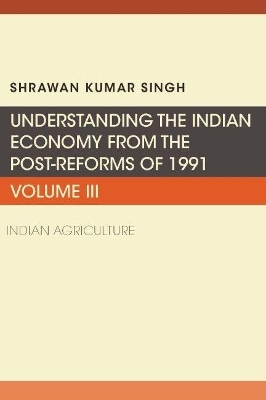
Understanding the Indian Economy from the Post-Reforms of 1991, Volume III
Indian Agriculture
Seiten
2021
Business Expert Press (Verlag)
978-1-953349-46-0 (ISBN)
Business Expert Press (Verlag)
978-1-953349-46-0 (ISBN)
India is the 21st largest exporter and the 11th largest importer in the world. For the sake of analysis the book is divided into Anatomy of Indian Economy; Agriculture Reforms; Industrial Reforms; Financial Sector Reforms; Fiscal and Monetary Policy Reforms; External Sector Reforms; and Contemporary Issues in Indian Economy.
In 1991, India adopted liberal and free-market principles and liberalized its economy. The economic reforms provided the market orientation to the economy to improve efficiency and productivity. The country's economic growth progressed with a relatively moderate increase in per-capita income. The economic reform has brought the challenge and the economy is in an adjustment mode the important factor is the smooth implementation of reforms.Currently India is called a developing economy. Macroeconomic variables help in obtaining a picture of major structural changes in India's economy. Such changes accompany economic development. The economy of India is the fifth-largest in the world by nominal GDP and the third-largest by purchasing power parity (PPP). The country is one of the G-20 major economies and a member of BRICS. According to the IMF, on a per-capita-income basis, India ranked 142nd by nominal GDP and 126th by GDP (PPP) in 2018.
India is the 21st largest exporter and the 11th largest importer in the world. For the sake of analysis the book will be divided into the following seven parts: Part I Anatomy of Indian Economy; Part II Agriculture Reforms; Part III Industrial Reforms; Part IV Financial Sector Reforms; Part V Fiscal and Monetary Policy Reforms; Part VI External Sector Reforms; Part VII Contemporary Issues in Indian Economy.
In 1991, India adopted liberal and free-market principles and liberalized its economy. The economic reforms provided the market orientation to the economy to improve efficiency and productivity. The country's economic growth progressed with a relatively moderate increase in per-capita income. The economic reform has brought the challenge and the economy is in an adjustment mode the important factor is the smooth implementation of reforms.Currently India is called a developing economy. Macroeconomic variables help in obtaining a picture of major structural changes in India's economy. Such changes accompany economic development. The economy of India is the fifth-largest in the world by nominal GDP and the third-largest by purchasing power parity (PPP). The country is one of the G-20 major economies and a member of BRICS. According to the IMF, on a per-capita-income basis, India ranked 142nd by nominal GDP and 126th by GDP (PPP) in 2018.
India is the 21st largest exporter and the 11th largest importer in the world. For the sake of analysis the book will be divided into the following seven parts: Part I Anatomy of Indian Economy; Part II Agriculture Reforms; Part III Industrial Reforms; Part IV Financial Sector Reforms; Part V Fiscal and Monetary Policy Reforms; Part VI External Sector Reforms; Part VII Contemporary Issues in Indian Economy.
As an academician, Shrawan Kumar Singh has experience in teaching, research, and writing that spans over six decades. Having served at the University of Delhi, Banaras Hindu University, and Ranchi University, he retired from the Indira Gandhi National Open University as professor and director of the School of Social Sciences. His field of interest is Indian economic policy, business environment, and international business. Shrawan has a number of publications to his credit in the form of books, articles, and papers in various journals. He has been a member of academic bodies such as the Academic Council and the Board of Courses of Studies as well as professional bodies.
| Erscheinungsdatum | 25.01.2021 |
|---|---|
| Verlagsort | Sterling Forest |
| Sprache | englisch |
| Maße | 152 x 229 mm |
| Gewicht | 333 g |
| Themenwelt | Wirtschaft ► Betriebswirtschaft / Management ► Finanzierung |
| Betriebswirtschaft / Management ► Spezielle Betriebswirtschaftslehre ► Bankbetriebslehre | |
| Wirtschaft ► Volkswirtschaftslehre ► Finanzwissenschaft | |
| Wirtschaft ► Volkswirtschaftslehre ► Makroökonomie | |
| Wirtschaft ► Volkswirtschaftslehre ► Wirtschaftspolitik | |
| ISBN-10 | 1-953349-46-3 / 1953349463 |
| ISBN-13 | 978-1-953349-46-0 / 9781953349460 |
| Zustand | Neuware |
| Haben Sie eine Frage zum Produkt? |
Mehr entdecken
aus dem Bereich
aus dem Bereich
warum unser Geld stirbt und wie Sie davon profitieren
Buch | Hardcover (2024)
FinanzBuch (Verlag)
30,00 €
denken und handeln wie ein professioneller Trader
Buch | Softcover (2023)
Vahlen, Franz (Verlag)
36,90 €


